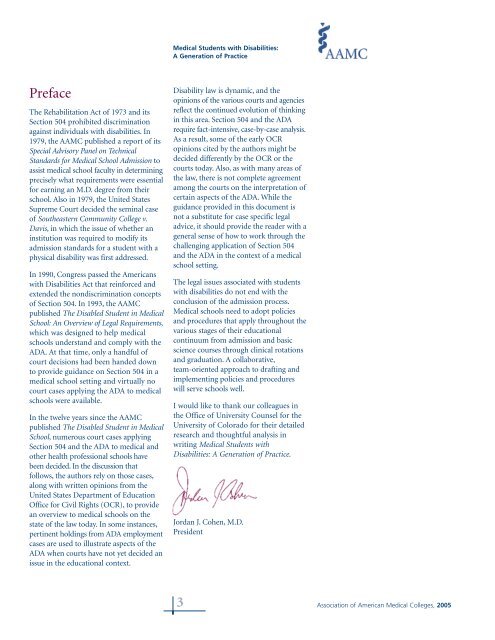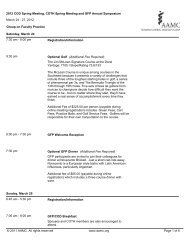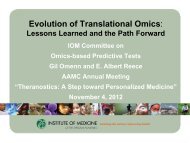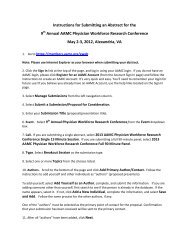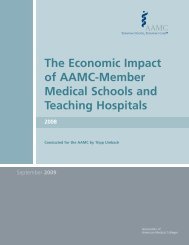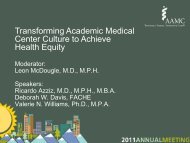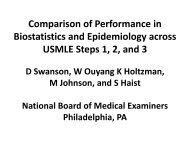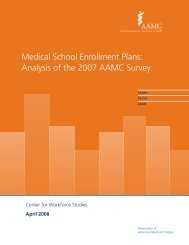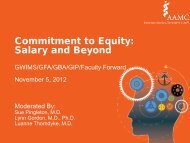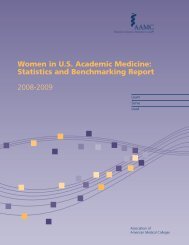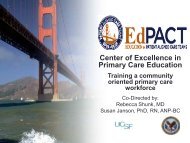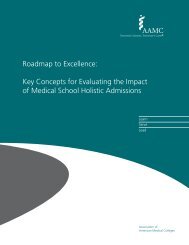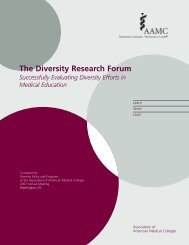Medical Students with Disabilities: A Generation of Practice
Medical Students with Disabilities: A Generation of Practice
Medical Students with Disabilities: A Generation of Practice
You also want an ePaper? Increase the reach of your titles
YUMPU automatically turns print PDFs into web optimized ePapers that Google loves.
<strong>Medical</strong> <strong>Students</strong> <strong>with</strong> <strong>Disabilities</strong>:<br />
A <strong>Generation</strong> <strong>of</strong> <strong>Practice</strong><br />
Preface<br />
The Rehabilitation Act <strong>of</strong> 1973 and its<br />
Section 504 prohibited discrimination<br />
against individuals <strong>with</strong> disabilities. In<br />
1979, the AAMC published a report <strong>of</strong> its<br />
Special Advisory Panel on Technical<br />
Standards for <strong>Medical</strong> School Admission to<br />
assist medical school faculty in determining<br />
precisely what requirements were essential<br />
for earning an M.D. degree from their<br />
school. Also in 1979, the United States<br />
Supreme Court decided the seminal case<br />
<strong>of</strong> Southeastern Community College v.<br />
Davis, in which the issue <strong>of</strong> whether an<br />
institution was required to modify its<br />
admission standards for a student <strong>with</strong> a<br />
physical disability was first addressed.<br />
In 1990, Congress passed the Americans<br />
<strong>with</strong> <strong>Disabilities</strong> Act that reinforced and<br />
extended the nondiscrimination concepts<br />
<strong>of</strong> Section 504. In 1993, the AAMC<br />
published The Disabled Student in <strong>Medical</strong><br />
School: An Overview <strong>of</strong> Legal Requirements,<br />
which was designed to help medical<br />
schools understand and comply <strong>with</strong> the<br />
ADA. At that time, only a handful <strong>of</strong><br />
court decisions had been handed down<br />
to provide guidance on Section 504 in a<br />
medical school setting and virtually no<br />
court cases applying the ADA to medical<br />
schools were available.<br />
In the twelve years since the AAMC<br />
published The Disabled Student in <strong>Medical</strong><br />
School, numerous court cases applying<br />
Section 504 and the ADA to medical and<br />
other health pr<strong>of</strong>essional schools have<br />
been decided. In the discussion that<br />
follows, the authors rely on those cases,<br />
along <strong>with</strong> written opinions from the<br />
United States Department <strong>of</strong> Education<br />
Office for Civil Rights (OCR), to provide<br />
an overview to medical schools on the<br />
state <strong>of</strong> the law today. In some instances,<br />
pertinent holdings from ADA employment<br />
cases are used to illustrate aspects <strong>of</strong> the<br />
ADA when courts have not yet decided an<br />
issue in the educational context.<br />
Disability law is dynamic, and the<br />
opinions <strong>of</strong> the various courts and agencies<br />
reflect the continued evolution <strong>of</strong> thinking<br />
in this area. Section 504 and the ADA<br />
require fact-intensive, case-by-case analysis.<br />
As a result, some <strong>of</strong> the early OCR<br />
opinions cited by the authors might be<br />
decided differently by the OCR or the<br />
courts today. Also, as <strong>with</strong> many areas <strong>of</strong><br />
the law, there is not complete agreement<br />
among the courts on the interpretation <strong>of</strong><br />
certain aspects <strong>of</strong> the ADA. While the<br />
guidance provided in this document is<br />
not a substitute for case specific legal<br />
advice, it should provide the reader <strong>with</strong> a<br />
general sense <strong>of</strong> how to work through the<br />
challenging application <strong>of</strong> Section 504<br />
and the ADA in the context <strong>of</strong> a medical<br />
school setting.<br />
The legal issues associated <strong>with</strong> students<br />
<strong>with</strong> disabilities do not end <strong>with</strong> the<br />
conclusion <strong>of</strong> the admission process.<br />
<strong>Medical</strong> schools need to adopt policies<br />
and procedures that apply throughout the<br />
various stages <strong>of</strong> their educational<br />
continuum from admission and basic<br />
science courses through clinical rotations<br />
and graduation. A collaborative,<br />
team-oriented approach to drafting and<br />
implementing policies and procedures<br />
will serve schools well.<br />
I would like to thank our colleagues in<br />
the Office <strong>of</strong> University Counsel for the<br />
University <strong>of</strong> Colorado for their detailed<br />
research and thoughtful analysis in<br />
writing <strong>Medical</strong> <strong>Students</strong> <strong>with</strong><br />
<strong>Disabilities</strong>: A <strong>Generation</strong> <strong>of</strong> <strong>Practice</strong>.<br />
Jordan J. Cohen, M.D.<br />
President<br />
3 Association <strong>of</strong> American <strong>Medical</strong> Colleges, 2005


